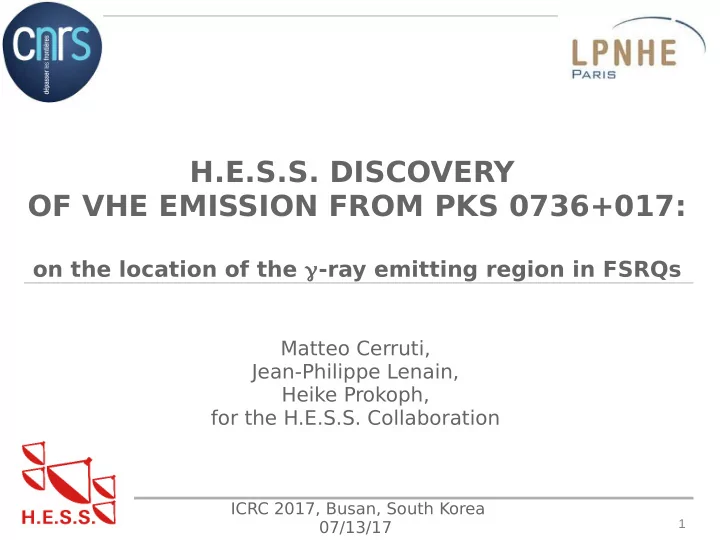

H.E.S.S. DISCOVERY OF VHE EMISSION FROM PKS 0736+017: on the location of the g -ray emitting region in FSRQs Matteo Cerruti, Jean-Philippe Lenain, Heike Prokoph, for the H.E.S.S. Collaboration ICRC 2017, Busan, South Korea 1 07/13/17
THE T eV (EXTRAGALACTIC) SKY tevcat.uchicago.edu 67 known VHE (E > 100 GeV) blazars only 6 are FSRQs due to: -lower peak frequency compared to HBLs -higher (average) redshift compared to HBLs 2
PKS 0736+017 Well known radio quasar z = 0.1894 (Ho & Kim 2009) ● typical FSRQ optical spectrum ● presence of big-blue bump ● SMBH mass = 10 8.47 M ☉ (McLure ● & Dunlop 2001) Host galaxy is a standard giant ● elliptical (Wright 1998, Kotilainen 1998, ++) Milkan & Moore, 1986 3
PKS 0736+017 Well known radio quasar Core-jet radio morphology ● (from MOJAVE) Lister & Homan, 2005 4
PKS 0736+017 Well known radio quasar Extreme optical fmare in 2002, ● with 0.6 mag/hr (which classifjes the source as Optically Violently Variable) Clements et al., 2003 5
PKS 0736+017 The source is detected by Fermi, and known as 3FGLJ0739.4+0137 Active in November 2014 (AT el ● 6731) and again in February 2015 ● (AT el 6975 from ASAS-SN) From automatic aperture photometry analysis of Fermi-LAT data 6
PKS 0736+017 : LAT results LAT likelihood data analysis – PASS8 – 12h bin „Double“ fmare in g -rays H.E.S.S. observations on 2015, Feb 18, 19, 21 7
H.E.S.S. II Array of 4+1 Cherenkov telescopes located on Khomas Highland, Namibia (23°16‘ S, 16°30‘ E) T wo difgerent reconstructions: Monoscopic (CT5 only) Stereoscopic (any 2 out of 5 telescopes) 8
H.E.S.S. II Array of 4+1 Cherenkov telescopes located on Khomas Highland, Namibia (23°16‘ S, 16°30‘ E) T wo difgerent reconstructions: Monoscopic (CT5 only) Stereoscopic (any 2 out of 5 telescopes) 9
H.E.S.S. II Array of 4+1 Cherenkov telescopes located on Khomas Highland, Namibia (23°16‘ S, 16°30‘ E) T wo difgerent reconstructions: Monoscopic (CT5 only) Stereoscopic (any 2 out of 5 telescopes) 10
PKS 0736+017 : H.E.S.S. results Discovery of VHE emission on the night of 2015 Feb 19 (both in Mono & Stereo reconstruction) H.E.S.S. Stereo H.E.S.S. Mono 5.5 s detection 11 s detection 11
PKS 0736+017 : H.E.S.S. results No detections during the other nights Correlation with the second Fermi-LAT fmare Time selection for contemporaneous LAT analysis 12
PKS 0736+017 : g -ray SED Fermi-LAT and H.E.S.S. spectra (mono & stereo) G = 2.15 ± 0.10 G mono = 3.1 ± 0.3 G stereo = 4.2 ± 0.8 Fermi-LAT spectrum extrapolated towards higher energies, including EBL absorption → spectral break between LAT and H.E.S.S. 13
PKS 0736+017 : X-ray and optical Swift T oO triggered by H.E.S.S., with three 4ks exposures on 2015, Feb 20, 22 and 23 → No simultaneous observations during the H.E.S.S. detection (Feb 19) Feb 20, 2015 ATOM long-term lightcurve: 14
PKS 0736+017 : MWL picture Day-by-day variability in H.E.S.S. data, but only Fermi-LAT simultaneous with H.E.S.S. H.E.S.S. Fermi-LAT XRT UVOT/ATOM 15
PKS 0736+017 : modeling - No simultaneous SED during the HESS detection & nigh-by-night variability → No SED modelling / fjtting - On the location of the g -ray emitting region using only g -ray information 16
PKS 0736+017 : modeling Hypotheses: - MeV to T eV emission is produced in the same region - Dominant radiative process in g -rays is leptonic (External-Inverse-Compton) - Variability time-scale ~12 hours (from Fermi-LAT) Constraints: - Opacity to g-g pair production on BLR photons (Bottcher & Els, 2016) - Collimation of the jet - Cooling time-scale (by EIC) is smaller than variability time-scale (Nalewajko++ 2014) 17
PKS 0736+017 : modeling Scattering on torus photons, G ~50 Collimation constraint Opacity constraint Cooling constraint Scattering on BLR photons, G ~10 R BLR Not possible, due to opacity 18
PKS 0736+017 : CONCLUSIONS PKS 0736+017 : conclusions Discovery of VHE emission from PKS 0736+017 - is the sixth VHE FSRQ - the second one discovered with H.E.S.S. Gamma-ray observations only can put constraints in the G -r plane 19
PKS 0736+017 : CONCLUSIONS PKS 0736+017 : conclusions Perspectives: At z=0.189 it is the nearest FSRQ The best one to study internal absorption At dec~0, easily visible by H.E.S.S. / MAGIC / VERITAS / FACT / HAWC → be ready for the next g -ray fmare 20
Recommend
More recommend